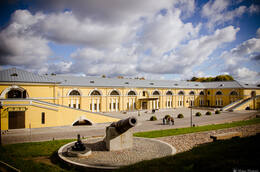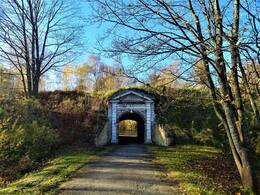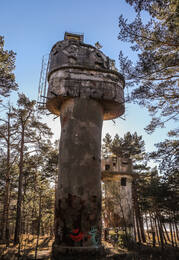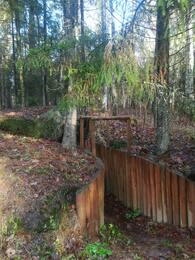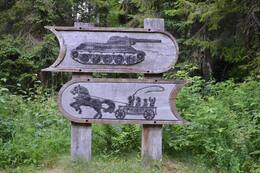Kaponieris
Kaponierius. (pranc. caponnière – niša) inžinerinis statinys priešais gynybinę poziciją, užtikrinantis flango ugnies perdavimą dviem priešingomis kryptimis. Tvirtovėse kaponierius leidžia šaudyti per visą gynybinio griovio ilgį. Šio tipo kaponierius tvirtovių statyboje naudojamas nuo XVII a. Žymiausias pavyzdys Latvijoje yra Daugpilio tvirtovė.
Šiuolaikinėse (XX a.) sausumos pajėgose – tai žemių pylimais aptverta teritorija, skirta apsaugoti kovinę techniką ir personalą nuo sprogimo smūginės bangos nešamų skeveldrų (taip pat nuo radiacijos branduolinio sprogimo atveju). Pylimo kaponieris papildomai maskuojamas tinklais, krūmais ir kt.
Daugiau informacijos šaltinių
Piemuo. Vikipedija. https://fr.wikipedia.org/wiki/Caponni%C3%A8re#D%C3%A9finition
Kaponiras. Vikipedija.
https://ex.uiss
https://ej.uz/gw1h
Multimedijos išteklius „Dinaburgo tvirtovė“ (nuotraukų galerija) http://dinaburgo tvirtovė.
Susijusi laiko juosta
Susijusios vietos
Daugpilio tvirtovė
Daugpilio tvirtovė – valstybinės reikšmės architektūros ir kultūros istorijos paminklas. Tai paskutinė pasaulyje pastatyta bastioninio tipo tvirtovė ir vienintelis Vidurio Europoje išlikęs XIX a. pirmosios pusės tvirtovės pavyzdys, išlikęs be didesnių pokyčių.
Tvirtovės statyba pradėta 1810 m., carinei Rusijai rengiantis Napoleono kariuomenės įsiveržimui, ir truko iki 1878 m. Dar nebaigus statybos, 1812 m., prie tvirtovės vyko rusų ir prancūzų karių mūšiai. Nors po Napoleono karų statybos buvo tęsiamos, jau tuomet tvirtovė ėmė prarasti savo karinę reikšmę.
Pirmojo pasaulinio karo metais (1915–1918) tvirtovė buvo Rusijos kariuomenės logistikos ir palaikymo bazė. 1918 m. vasarį ją užėmė vokiečių kariuomenė, o gruodį – bolševikai. 1920 m. sausį tvirtovę užėmė lenkų kariai, padėję Latvijos kariuomenei išlaisvinti Latgalą nuo bolševikų. Tarpukariu, 1920–1940 m., tvirtovėje buvo dislokuota Latvijos kariuomenės 4-oji Žiemgalos divizija.
1940 m. okupavus Latviją, tvirtovėje įsikūrė Raudonosios armijos daliniai, o vokiečių okupacijos metais čia buvo karo belaisvių stovykla „Stalag-340“. Po 1944 m. sovietų sugrįžimo tvirtovė vėl atiteko sovietinei armijai. Latvija tvirtovę atgavo tik 1993 m., kai iš jos pasitraukė Rusijos kariuomenė.
Daugavgryvos tvirtovė
Daugavgryvos tvirtovė (įėjimas iš Birzės gatvės) yra Daugavgryvos saloje, kur Bulupės upė įteka į Dauguvos upę. Tvirtovė buvo pastatyta XVII a., siekiant apsiginti nuo priešų, judančių Rygos kryptimi, kuri buvo svarbus administracinis, prekybos ir gamybos centras. Vėliau ji tapo pagrindiniu Latvijos armijos pakrantės gynybos įtvirtinimu su keliais atramos taškais. Ši gynybinė įtvirtinimų sistema yra vienas vertingiausių Latvijos karinio paveldo objektų. Ši tvirtovė yra Latvijos karinės istorijos liudininkė. Pavyzdžiui, Krymo karo metu (1853–1856 m.) čia buvo mokomos Latvijos ir Estijos patrankinių valčių įgulos. Pagrindinis šių dalinių tikslas buvo ginti vietos uostus ir pakrantę nuo britų karinio jūrų laivyno atakų. Pirmojo pasaulinio karo metu čia buvo suformuotos Daugavgryvos milicijos kuopos. Tai buvo pirmieji Latvijos koviniai daliniai, atsiradę dar anksčiau nei Latvijos šauliai. Šiandien galima pamatyti tvirtovės teritoriją. Netoliese yra Kometfortas ir Pajūrio gamtos parkas, o kitoje Dauguvos pusėje – Mangaļsalos įtvirtinimai.
Karosta, Liepojos karinis uostas (ekskursija)
Karosta yra didžiausia istorinė karinė teritorija Baltijos šalyse ir užima beveik trečdalį visos Liepojos teritorijos. Karosta – unikalus karinių ir įtvirtinimų pastatų kompleksas Baltijos jūros pakrantėje, turintis ypatingą reikšmę Latvijos ir pasaulio istorijoje bei architektūroje. Karostoje yra tokie karinio paveldo objektai kaip Šiaurinis molas ir fortai, Redanas, Karostos kalėjimas, Karostos vandens bokštas, Šv. Nikolajaus stačiatikių Jūros katedra, Oskaro Kalpako tiltas ir kiti.
Raudonosios armijos bunkeris ir kaponieriai Aizvykių parke
Aizvykių dvaro parkas yra Aizvyčiuose, Gramzdos valsčiuje, vos už kelių kilometrų nuo Lietuvos sienos.
Aizvykių parke vis dar aiškiai matomos Antrojo pasaulinio karo bunkerių ir apkasų vietos. Parke restauruotas Raudonosios armijos bunkeris.
Vienas iš Antrojo pasaulinio karo ginklų tipų buvo raketų paleidimo sistema „Katiuša“. Kelios tokios raketų paleidimo sistemos buvo įsikūrusios Aizvykių parke, ir net šiandien šios vietos (kaponieriai) yra aiškiai matomos gamtoje.
Norint geriau pažinti Aizvykių dvaro parko kultūrinį ir istorinį paveldą, rekomenduojame pasinaudoti gido paslaugomis.
Antrojo pasaulinio karo liudijimai Aizvykių parke
Aizvykių dvaro parkas yra Aizvyčiuose, Gramzdos valsčiuje, vos už kelių kilometrų nuo Lietuvos sienos.
Aizvykių parke vis dar aiškiai matomos Antrojo pasaulinio karo bunkerių ir apkasų vietos. Vienas iš ginklų tipų buvo raketų paleidimo sistema „Katyusha“. Kelios tokios raketų paleidimo sistemos Aizvykių parke buvo ir pasibaigus Antrajam pasauliniam karui, ir šios vietos (kaponieriai) yra aiškiai matomos gamtoje.
Šis unikalus miško parkas, apipintas paslaptimis ir legendomis, buvo įkurtas XIX a. pabaigoje kaip Aizvykių dvaro parkas, kai dvaro baronas fon Korfas netoliese esančią kalvotą žemę apsodino pušų ir eglių mišku. Vėliau 40 hektarų plote buvo įrengti pėsčiųjų takai, pasodinta ir kitų rūšių medžių, įkurtas fazanų sodas.
Be vaizdingų miško peizažų, parke taip pat yra medinių pasakų ir legendų personažų, taip pat akmens skulptūrų, kurios keliautojams pasakoja apie Aizvykių istorijos įvykius ir žymi kultūrines bei istorines vietas. Parke taip pat yra Žalioji klasė.
Norint geriau pažinti Aizvykių dvaro parko kultūrinį ir istorinį paveldą, rekomenduojame pasinaudoti gido paslaugomis.




